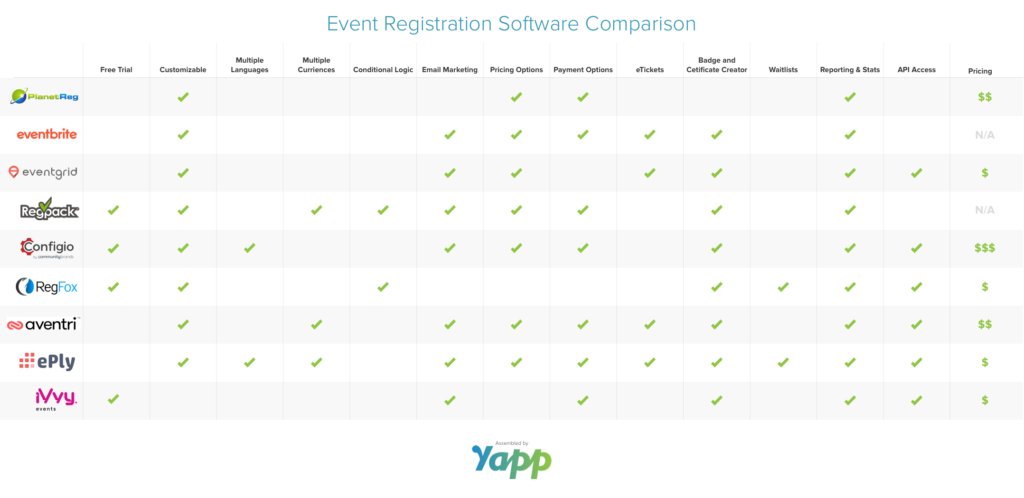Registration platforms are becoming the norm for larger events. Especially when you want to do away with using Excel and sheets of check-marked paper to manually register every new person who walks into the venue. Registration platforms can also be very useful if you host an online event and want to make sure people purchase their tickets before they get access to the material.
With over 60 registration software providers out there, it can be daunting to pick the right one. That’s why we created a matrix that quickly compares the leading options (scroll to the bottom of this post to view the competitive table).
1. The importance of a Free Trial
At Yapp, the leading provider of mobile apps for your conference or event, we strongly believe in the importance of a free trial. A company that offers you a free trial is a company that believes in their product, is not trying to hide anything, and wants you to experience their product and make sure there is a fit. This is why the first column in the comparison table below outlines the event registration providers that offer you the opportunity to take their product for a spin before purchasing. A free trial will do more than a list of features to let you know whether you will enjoy working with this particular software for years to come. So before you commit to a solution, take advantage of the trial by putting the software through its paces. Use it, try it and test it. Be aware that some products that claim to be “free” to use actually charge a fee or percentage per registrant and don’t truly provide an option for a true no-cost trial.
2. Branded Pages, Customizable Forms
The good news here is that if you really want your registration pages, badges, and forms to reflect your brand you are in luck. 90% of the registration platform providers we reviewed offer the ability to customize.
3. The Bells and Whistles
A few event registration software providers such as Regpack and Regfox are really ahead of the field when it comes to features such as conditional logic, waitlists for sold out events and multiple currencies for international visitors and events. While these features can be nice to have for some, think carefully about what you actually need when you make your decision. One of the stories we hear most often during our Yapp Demos is “We’re looking to get away from [insert very expensive software here] because we are paying for elaborate features we’re not using!” Determine your event’s needs and pick your software based on those needs to make sure you don’t end up overpaying for unnecessary features.
4. Customer Service and Support
You will not find a column for customer service anywhere in the table below. That being said, it is one of the most important things that should factor in your decision of which registration platform provider to go with.
The worst case scenario is something going wrong on the day of your event and being unable to reach anyone at the company. There are a few things that you can do to gauge whether the company will step up in this department.
- How was their pre-sales process? If you have a hard time connecting with them pre-sale, it doesn’t bode well for customer service after you’ve paid them.
- Ask for some help during your trial. How responsive was the support team?
- Do they offer phone support?
- Are they quick to answer email? Or better yet, do they have live chat?
5. Budget
While a few registration platform providers such as Regpack, Eventbrite and Configio actually have a transparent pricing page, a lot of the providers do not post pricing on their website and will want you to contact them instead. Pricing schemes in the industry vary wildly so choose carefully and make sure to ask about hidden or extra costs.
It’s also important to understand how each registration platform charges you. At first glance, one provider may seem less expensive than the other, but make sure you understand how they are charging. Some providers will charge per ticket plus a percentage. Other providers will charge per ticket only. If the charges are per ticket plus a percentage, make sure that you understand how that will impact your costs.









